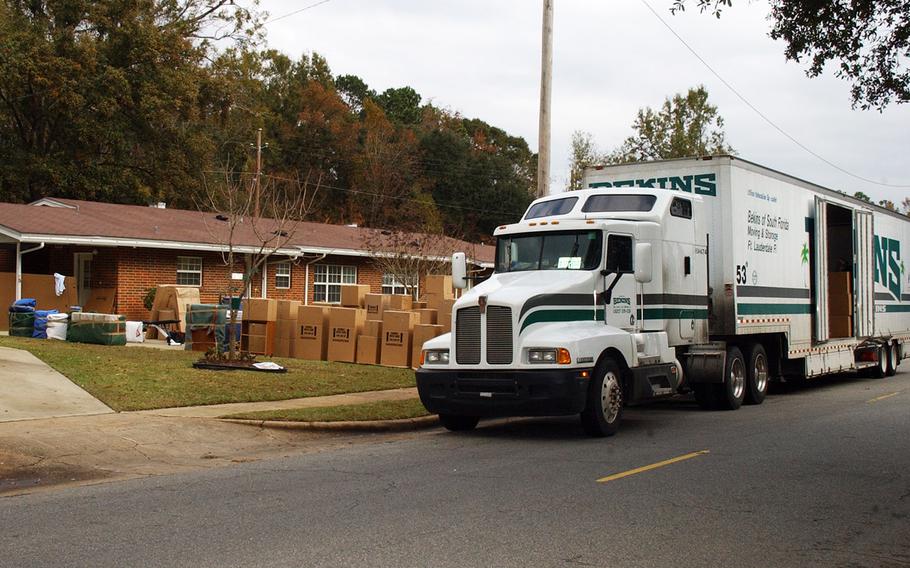
(DOD)
Army officials bracing to move some 90,000 soldiers in the summer announced Tuesday that the service will pay the expenses for troops to pack and move their belongings themselves.
The increase from the 95% reimbursement rate of the government’s estimated moving cost is meant to make the so-called “personally procured” moves a more attractive option for soldiers, said Maj. Gen. Michel Russell Sr., the Army’s logistics commander. The Army – and other military services – initiated 100% reimbursements last year on a temporary basis, but the decision is now to make it permanent, reflecting the first rate change for self-moves since it was upped from 80% to 95% in 1998.
“That puts more money in our soldiers’ and families’ pockets,” Russell told reporters Tuesday. “It incentivizes them to do their own moves with the conveyances they choose, and in a [coronavirus pandemic] environment, it also allows them to maintain their healthy bubble by doing things themselves.”
It would also release at least some burden on government-contracted moving companies as the Army plans to return to a normal move schedule during the summer’s permanent-change-of-station season, which traditionally runs from May through August. The Army expects to move some 90,000 soldiers this year, including domestic and overseas moves, said Derrick Candler, who leads the Army’s transportation policy division. The service moved about 72,000 soldiers last year in an unusual season that stretched well into the fall, he said.
Despite the increased incentive last year, the Army only saw a minor uptick in the percentage of soldiers choosing to conduct personally procured moves, which used to be known as do-it-yourself, or DITY, moves, Candler said. Last year, about 23% of soldiers moved themselves up from about 21% in 2019 and 2018.
The Army has also simplified the process to request a self-move and to be reimbursed afterward, Russell said.
“We’ve done a lot of things to entice our service members to want to use this process, which in the past may have been seen as more of an effort versus the benefit, so they’ve just relied on having someone else do it for [them],” he said. “We’ve made it easier, more efficient and effective … than it was in the past.”
The increased incentive was one of several PCS changes that Army officials wanted to undertake after the pandemic brought new issues to the process last year, according to Russell. As the coronavirus reached American shores and quickly spread through all 50 states last March, the Pentagon for several months temporarily halted almost all military movement, including virtually all moves.
That created a backlog of moves for the services as they began conducting high-priority moves in April and gradually lifted some restrictions as the military learned how to conduct PCS moves while attempting to minimize the spread of the virus.
Candler said those protocols – including increased cleaning at soldiers’ new and old quarters, mask wearing and social distancing – appeared to have worked. While the Army was made aware of cases in which movers and family members tested positive for coronavirus after a move, he said contact tracers did not establish that any transmissions occurred between Army families and movers in 2020.
Another improvement to the PCS process that Russell touted was a drastic increase in the time between when soldiers receive their PCS orders and they are due to report for their new job. On average, soldiers now are receiving their orders about 120 days before they must arrive at their next assignment, Russell said, up from just 30 to 60 days in previous years.
The extra time, the general said, should allow soldiers to better prepare their moves.
“It allows you to prepare yourself and your family sooner. It allows you to schedule a household goods [move] appointment even earlier. It allows you to receive a sponsor on other end [of the move] sooner,” Russell said. “It just benefits you in so many ways, in terms of early and proactive planning, versus having to do reactive planning, where we may have been in the past.”
Last year, the Army also launched a smartphone application that it hopes will help soldiers better navigate their moves. The app called Army PCS Move is available in Apple’s App Store and on Google Play.
“We’re very proud of that app,” Russell said. “The intent of it was to take all the information out there … and consolidate factual information in one place.”
Soldiers can use the app for moving research, to book movers and track where they are in the moving process, Russell said. It can also help soldiers file a claim if their belongings are lost or damaged during a move.
To date, Russell said the app has been downloaded some 13,000 times.
“This basically allows them to take back control of how they conduct a PCS move,” he said. “Knowledge is power, and the goal is to give the force the power to help us help them improve the PCS move experience.”